This is our review of the best Wi-Fi boosters for Spectrum Internet plans in 2024.

We picked up a few Wi-Fi repeaters and extenders to test, and we’d like to share our findings with you.
After careful evaluation, the TP-Link RE650 AC2600 is our top pick for the best Wi-Fi extender for Spectrum. It’s easy to use, quick, and doesn’t cost a fortune.
Editor’s Choice – TP-Link RE650
Best Overall
- Coverage: ~70 feet
- Max speed (Wi-Fi): 332.58 Mbps
- Separate networks: Yes (not with TP-Link routers)
- Recommended for: Spectrum GIG or below (1000 Mbps)
- Wireless standard: Wi-Fi 5 AC2600
- Warranty: 3 years
However, the ideal extender for your house depends on your specific demands and circumstances. No one has the same home, router, and internet package, which plays into which extender is the best fit.
As a result, we’ve compiled a list of the top 6 extenders for Spectrum so you can choose the best one for your circumstance.
To learn all about the top six Wi-Fi extender solutions, keep reading.
Top 6 Wi-Fi Extenders For Spectrum
- TP-Link RE650 AC2600 – Best Overall
- TP-Link RE605X AX1800 – Best Wi-Fi 6
- Netgear EAX80 AX6000– Best Performer
- Netgear EAX20 AX1800 – Runner Up
- Linksys RE7000 AC1900 – Best Value
- TP-Link RE315 AC1200 – Budget Friendly
6 Best Wi-Fi Extenders For Spectrum
Here are our brief reviews of the top Wi-Fi boosters/repeaters for Spectrum internet.
#1 TP-Link RE650 AC2600 – Best Overall
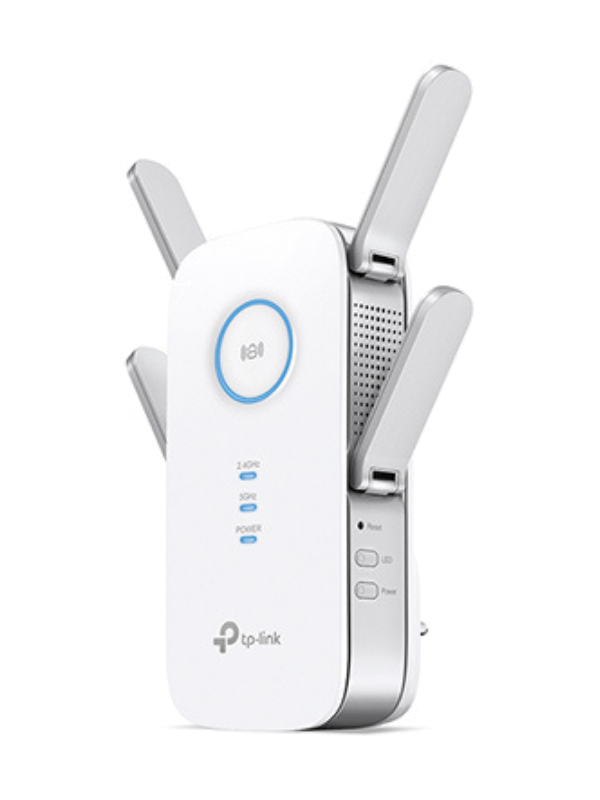
- Coverage: ~70 feet
- Max speed (Wi-Fi): 332.58 Mbps
- Separate networks: Yes (not with TP-Link routers)
- Recommended for: Spectrum GIG or below (1000 Mbps)
- Wireless standard: Wi-Fi 5 AC2600
- Warranty: 3 years
Pros
- Fantastic speed
- 3-year warranty
- Best range of all extenders we have tested
Cons
- Creates a secondary network
The TP-Link RE650 is, from our tests, the best-performing Wi-Fi extender on the market. It offers a superb range, incredible speeds, and a user-friendly design, making it an excellent choice for anyone looking to extend their home network.
And, if you have a TP-Link router, you’re still in luck. You can use OneMesh to make a single network. Unfortunately, if you have a different router brand, it will make a secondary network (unless you connect with Ethernet).
The setup process is simple and only takes a few minutes. Once you’ve plugged in the device and connected it to your router, you use the Tether app to finish the installation.
It has the best range out of all the extenders we tested. It achieved:
- 70 feet on Wi-Fi
- 80 feet on Ethernet
Which might be enough range to let your neighbor’s neighbor use your Wi-Fi. (A bit of an exaggeration, but more than enough to cover huge homes.)
Along with its great range, the RE650 is speedy too.
At five feet, it delivered outstanding speeds on the 5 GHz band of:
- 332.58 Mbps on Wi-Fi
- 657.23 Mbps on Ethernet
So fast that you could download large video game files (100+ Gb) in a matter of hours while streaming 4k movies.
The TP-Link RE605 AC2600 is a fantastic extender that pairs well with Spectrum’s Internet GIG plan and lower. It has amazing coverage, fast speeds, and an easy setup.
It just has the slight downside of creating a second network (unless you use OneMesh or connect to the router using Ethernet).
#2 TP-Link RE605X – Best Wi-FI 6
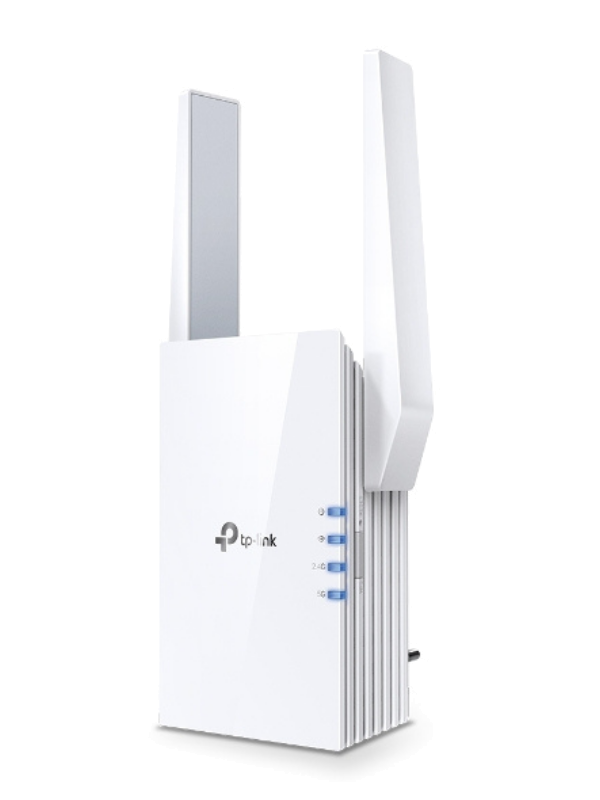
- Coverage: ≈ 60 feet
- Max speed (Wi-Fi): 346.35 Mbps
- Separate networks: Yes (not with TP-Link routers)
- Recommended for: Spectrum GIG or below (1000 Mbps)
- Wireless standard: Wi-Fi 6 AX1800
- Warranty: 3 years
Pros
- Fast speeds
- 3-year warranty
- Quick and easy setup
Cons
- Separate networks
The TP-Link RE605X AX1800 Wi-Fi booster is the most effective with the “Internet GIG” plan, but will also wor great the any of the slower Spectrum plans.
The TP-Link booster’s installation was incredibly easy. All you have to do is connect to the Wi-Fi network and follow the Tether app’s step-by-step instructions. Removing it from the box took longer than setting it up (less than 60 seconds).
We should add that this wasn’t our first time using an extender (not. even. close). But it is so straightforward that anyone can do it.
The TP-Link RE650 boosted our Wi-Fi signal by an amazing 70 feet over Wi-Fi, further than any other model we tested.
And we added 10 feet to our range on Ethernet, lifting it to 80 feet.
This is an incredible range, enough to cover your entire house and maybe even your neighbor’s house too.
At 5 feet on Ethernet (5 GHz), it achieved a speed of 674.53 Mbps during testing. And on Wi-Fi, it reached 346.35 Mbps at 5 feet using the 5 GHz band, 268.04 Mbps at 15 feet, and 257.04 Mbps from 25 feet.
Are these download speeds good or bad? Here’s a reference point– 350 Mbps is enough to stream ten 4k movies simultaneously!
So, you can download virtually anything in a matter of minutes.
I should point out that we tested this extender with an excellent router, the ASUS RT-AX88U. If you’re using a slow or old router, your extender’s performance will be restricted by your router’s speed.
The only disadvantage of the RE605X AX1800 is that it makes a second network if you don’t have a TP-Link router with OneMesh. So as you travel throughout your house with your smartphone or laptop, you’ll need to switch networks to get the best connection.
If you connect it to the router via an Ethernet cable, you will have a single network.
If you have Spectrum internet but don’t want to deal with multiple networks, consider connecting to Ethernet instead. Spectrum uses Arris routers and Arris doesn’t make extenders so you can’t match their brand.
The TP-Link RE605X AX1800 is a fantastic option for extending your home network. It has excellent range, quick transmission speeds, and a simple setup, making it a great value.
The RE605X’s single disadvantage is that it uses a secondary network with routers that don’t have OneMesh (unless you connect it to Ethernet).
#3 Netgear EAX80 AX6000 – Best Performer
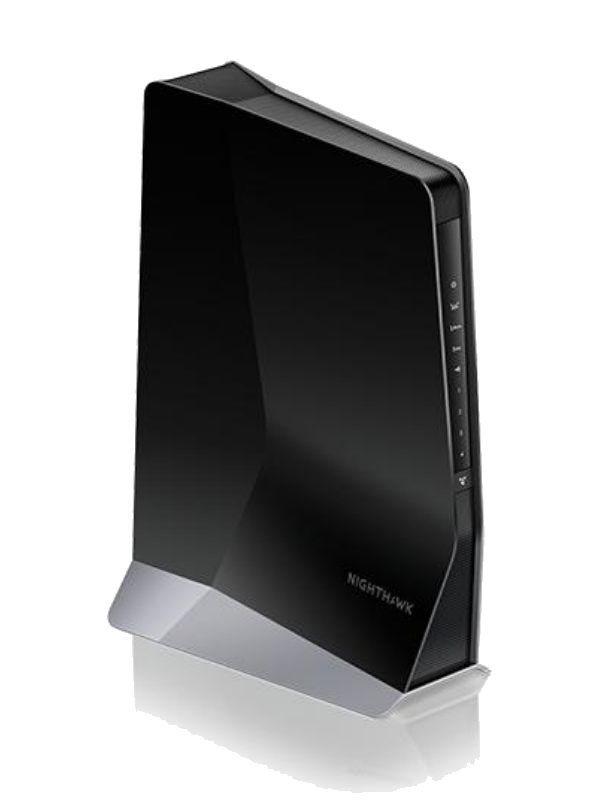
- Coverage: ≈ 65 feet
- Max speed (Wi-Fi): 437.34 Mbps
- Separate networks: No
- Recommended for: Any Spectrum internet plan
- Wireless standard: Wi-Fi 6 AX6000
- Warranty: 1-year
Pros
- Amazing range
- Single network
- Fast we have tested
Cons
- Some problems setting up
- More expensive than other options
The Netgear EAX80 (click here to read our full review) is our recommendation for you with the Spectrum Gigabit plan.
Because this is the fastest extender we have tested that can boost your Wi-Fi signal by an additional 65 feet and 75 feet on Ethernet.
That is enough range to cover any Wi-Fi dead zone in most homes.
The EAX80 extender can deliver speeds of up to 436.34 Mbps on Wi-Fi and 811.59 Mbps on Ethernet at five feet using the 5 GHz band, thanks to its built-in 4×4 MU-MIMO antenna.
With a performance that fast, it can download a 100 GB video game in less than forty minutes.
The Netgear EAX80 also supports the new 802.11ax wireless networking standard (Wi-Fi 6). Making it more secure, faster, and better at handling many smart devices. And it works with every router from Spectrum.
The EAX80 has a unique advantage over many other extenders – it merges its network with your router, making it a single network. Thus, you can explore your house without worrying about the network you’re using if you use a mobile device.
The EAX80 has fantastic speed and range, but our experience wasn’t 100% positive.
It was more difficult to set up than other models we’ve tested; it took us much longer. We also had to totally reset the EAX80 when we switched from Wi-Fi to Ethernet to get it working again.
However, it worked fine after these hiccups.
It’s also way pricier than the other five extenders we recommend in this guide.
Despite its flaws, the Netgear EAX80 AX6000 is an excellent choice if you’re looking for a Wi-Fi extender that can provide the widest possible range and good performance.
#4 Netgear EAX20 AX1800 – Runner Up
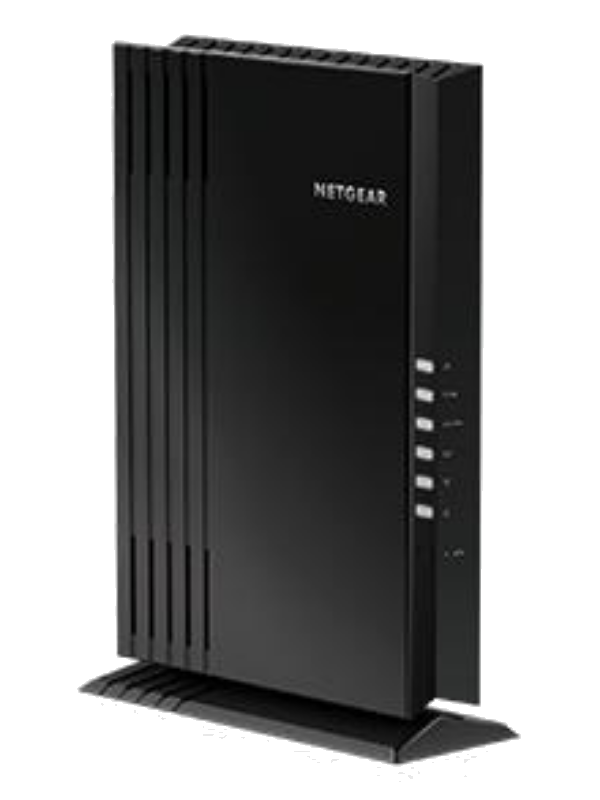
- Coverage: 50 feet
- Max speed (Wi-Fi): 398.67 Mbps
- Separate networks: No
- Recommended for: Spectrum Ultra or below (400 Mbps)
- Wireless standard: Wi-Fi 6
- Warranty: 1-year
Pros
- Fast speed
- Great value
- Single network
Cons
- More complex setup
The Netgear EAX20 AX1800 is a great all-around option. It isn’t the top-performing extender on this list, but it delivers a good balance of performance to price.
The EAX20 provides a good range at 50 feet on Wi-Fi and 60 feet on Ethernet. But it is outperformed by many other extenders in this list.
However, it’s still adequate to cover the majority of homes.
This compact extender performed decently in our speed test, but nothing to write home about. At 5 feet, it recorded a speed of 398.67 Mbps and 276.69 Mbps at 15 feet.
At 25 feet, the connection rate was 236.7 Mbps.
Which is more than enough throughput to stream a handful of 4k movies at the same time.
The speed rose to 609.81 Mbps when we connected Ethernet, a decent bump. But it wasn’t quite as significant an increase as some of the other models we tested.
However, it is still plenty quick for most homes.
The EAX20 also merges its network with your router’s network. So you don’t have to switch networks when you move around your home.
Setting up the EAX20 was not as simple as we had hoped. The device informed us that the network password was incorrect (even though it wasn’t). We had to move the router closer for it to connect (and now the password is correct all of a sudden).
However, the Netgear EAX20 AX1800 is still a decent all-around choice. Despite some initial setup problems. And if you want more speed, connect this extender to your router using Ethernet.
#5 Linksys RE7000 AC1900 – Best Value
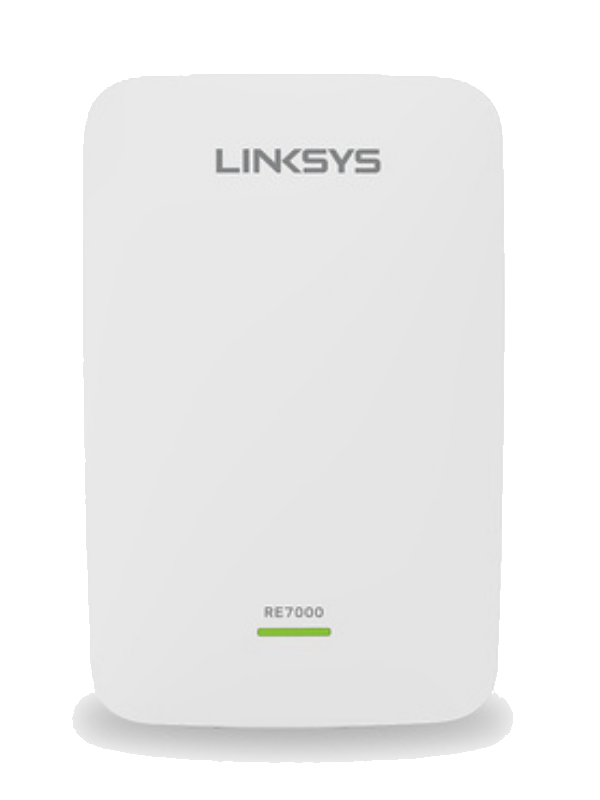
- Coverage: 60 feet
- Max speed (Wi-Fi): 320.83 Mbps
- Separate networks: Yes
- Recommended for: Spectrum Ultra or below (400 Mbps)
- Wireless standard: Wi-Fi 5
- Warranty: 3-years
Pros
- Budget-friendly
- Great range
- Decent speeds
Cons
- Creates a separate network
- Long setup
The Linksys RE7000 AC1900 Wi-Fi extender is our top pick for the best bargain.
The RE7000 boosted our Wi-Fi signal up to an additional 60 feet on Wi-Fi. It also extended our Wi-Fi signal up to 70 feet on Ethernet and provided speeds of up to 320.83 Mbps at 5 feet on the 5 GHz band.
An extra 60 to 70 feet of Wi-Fi range can bring internet to the entire floorplan of large, multi-story homes and even a detached garage.
The speed improved to 519.73 Mbps at 5 feet when connected via Ethernet. Which is even better.
These speeds are not as quick as other extenders on this list, but they are fast enough for most homes.
You’ll be able to stream 4K videos, participate in a video conference, and download large files simultaneously without any trouble.
The Linksys RE7000 comes with an ethernet connection, so it can be connected directly to your modem, router, or laptop. This will offer you the highest possible speeds.
The setup process is simple, and we completed it using the Linksys app (but you can use the web interface too). The mobile app guides you through each step, so setup is easier.
The setup procedure took us around 10 minutes due to long load times. It is quite a bit longer than the few minutes it took us with other extenders.
The Linksys RE7000 also creates a new network, no matter what router you have. Suppose you only want one network in your house and don’t want to deal with switching between networks when you move around the home. Then, this extender may not be ideal for you.
However, if you simply want to improve your Wi-Fi signal, this is a fantastic choice.
Overall, the Linksys RE7000 AC1900 Wi-Fi extender is a great value choice because it’s one of the more affordable Wi-Fi extenders and yet provides reasonable speeds.
#6 TP-Link RE315 AC1200 – Budget-Friendly
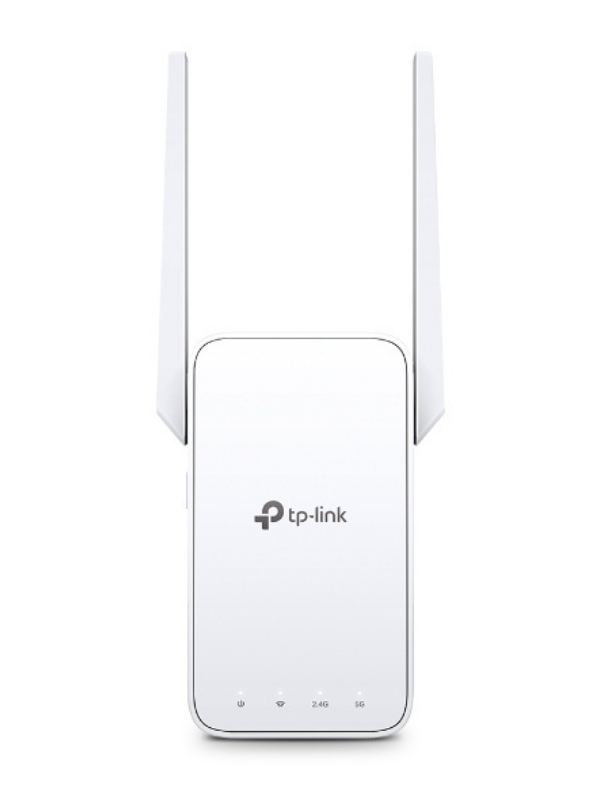
- Coverage: 60 feet
- Max speed (Wi-Fi): 187.61 Mbps
- Separate networks: Yes (unless you use OneMesh)
- Recommended for: Spectrum’s “Internet” plan (100 Mbps)
- Wireless standard: Wi-Fi 5
- Warranty: 3 years
Pros
- Easy setup
- Decent range
- Fast enough for Spectrum’s entry plan
Cons
- Creates a second network
- Slower than other extenders
The TP-Link RE315 AC1200 is our budget-friendly pick. It provides excellent speed and range, perfect for homeowners with Spectrum’s “Internet” plan (200 Mbps).
The RE315 extended our Wi-Fi signal up to an impressive 60 feet on Wi-Fi and 70 feet on Ethernet. Enough to bring Wi-Fi to every room in your home.
It also delivered speeds of up to 187.61 Mbps at 5 feet away and 165.21 at 15 feet on the 5 GHz band (when connected via Wi-Fi).
The speed improved a bit to 302.51 Mbps when we connected the extender directly to our router with an Ethernet cable.
This is more than enough speed for most homes using Spectrum’s lowest-tier Internet plan.
This budget-friendly model creates one network instead of two using a TP-Link router with a OneMesh or Ethernet connection. Otherwise, it creates another network.
In that case, you will have to constantly switch networks as you move around your home.
The TP-Link RE315 AC1200 is also very easy to set up. We could do it in just a few minutes using the TP-Link Tether mobile app.
Overall, the TP-Link RE315 AC1200 is a great budget-friendly choice, especially for those with Spectrum’s base internet plan. The reason is simple– it’s one of the more affordable Wi-Fi extenders and yet provides adequate speeds and great range.
The only downside is creating a secondary network if you don’t use OneMesh or Wi-Fi.
Do you need a Wi-Fi Extender?
If you’re experiencing any of the following problems, you might need a Wi-Fi extender:
- Slow internet speeds
- Weak Wi-Fi signal
- Dead zones in your home
- Buffering or lag when streaming content and gaming online
If your Spectrum internet speeds are slow, it’s worth looking into a Wi-Fi extender. But, you might be able to fix your slow Wi-Fi in a different way.
For example, simply moving your router to a central location might help.
Or, let’s say you live in a large home with numerous Wi-Fi dead zones and utilize a lot of smart home sensors. In that case, a Mesh network might be the way to go.
Another alternative is upgrading your modem or router with a new one. We recommend replacement if they’re older than five years.
If you want to upgrade your modem or router, check out our modem and router reviews and recommendations for Spectrum to see our top choices.
Spectrum Wi-Fi Extender Buying Guide
Here are the top considerations you should consider while you shop for a Wi-Fi booster for your Spectrum home internet.
Match the Brand
Even though most Wi-Fi extenders work with every router, we still recommend matching them.
For example, if you’re a Spectrum customer with a TP-Link router, you might want to get a TP-Link extender.
The upside to matching brands is that the process of setting up and connecting your devices will be much simpler. We’ve found this to be especially the case for certain brands, but your mileage may vary.
Wi-Fi 5 vs. Wi-Fi 6
The newest wireless standard is Wi-Fi 6, which offers a few advantages over the last generation of Wi-Fi 5. It mainly has faster speeds, larger bandwidth, and the ability to connect more devices.
Wi-Fi 6 also has lower latency, so there’s less lag when you’re gaming or on a Zoom call.
It also transmits data faster but uses less energy, which can help save battery life on your devices.
And finally, it can connect to more devices simultaneously without slowing down the network.
If you have a Wi-Fi 6 router, we recommend getting a Wi-Fi 6 extender. Even if you don’t have one, it’s backward compatible with Wi-Fi 5 and could help you future-proof your home network.
But, a Wi-Fi 5 extender will still work just fine and be cheaper too.
Check out our Wi-Fi 5 vs. Wi-Fi 6 guide to learn more.
What if my Router is Wi-Fi 4?
The best option is to update your router to a Wi-Fi 5 or Wi-Fi 6 unit. This will improve your speeds and range and future-proof your home network.
If you’ve been with Spectrum for a while and they provided you with the router, ask them for a replacement. You should particularly request one if you’re on their Internet GIG or Internet Ultra plans.
Otherwise, you’re probably not able to use what you’re paying for.
Dual-band vs. Tri-band
All Spectrum routers come equipped with at least dual-band capabilities, which means they broadcast both the 2.4GHz and 5GHz frequencies.
Newer tri-band Spectrum routers broadcast three different frequencies: two 5GHz bands and one 2.4GHz band.
The extra 5 GHz band helps for data-intensive activities like gaming, 4K streaming, and with homes with many smart wireless devices.
For most people, a dual-band extender will work just fine. But, if you live in a larger home with a lot of devices or Wi-Fi dead zones, you might want the added range and speed that a tri-band extender can give you.
Note: you don’t have to get a dual-band extender if you have a dual-band router. Dual-band routers work with tri-band extenders and vice-versa.
Learn more about dual-band and tri-band here.
Coverage
When you’re looking for an extender, you’ll want to make sure that it can cover the area that you need.
Most homes with Spectrum Internet will do just fine with a single-unit extender like the TP-Link RE650.
To “size” an extender, you’ll need to know your home’s square footage and the extender’s range.
The extenders we tested had a range of roughly 50-80 feet. This is usually more than enough for most houses.
However, most Wi-Fi boosters’ range that they advertise is inaccurate. We tested several models and discovered that they achieve roughly 70% to 120% of their claimed range.
So, to account for this, buy a Wi-Fi extender with a 30% longer range than you require. That way, you’ll be sure to have enough range to get your Spectrum Wi-Fi to every nook and cranny in your home.
Connected to the Router Using Ethernet or Wi-Fi
One of the first things you’ll need to do when setting up your new extender is to choose how it will connect to your router.
You can either connect it using an Ethernet cable or wirelessly via Wi-Fi.
If you’re able, we recommend connecting your extender to your router with an Ethernet cable.
This will give you the fastest and most reliable connection between the two devices.
Plus, if you have a lot of devices on your network that are streaming 4K video or gaming, this extra bandwidth with Ethernet can help prevent buffering and lag.
Not everyone has an easy way to connect their extender to their router with an Ethernet cable. In this case, don’t worry! You can still use Wi-Fi to connect the two devices.
The only downside to this is that you’ll use some of your bandwidth to connect the extender to the router.
This isn’t a huge deal for most people (like if you have Spectrum’s basic Internet plan), but it’s something to keep in mind.
So, what mode is best?
If you have Ethernet connections conventionally located where you need to place your Wi-Fi extender, then use Ethernet. If not, then you should use Wi-Fi.
Just remember, if you use Wi-Fi to connect the two devices, your speeds will be slower than if you were to use Ethernet.
Also, if you have a faster plan like Spectrum’s Internet GIG, an Ethernet connection to your extender will help you take full advantage of its speed.
Mesh Wi-Fi vs. Wi-Fi Extender/Repeater
If you’re in the market for a new Wi-Fi solution for your home, you might be wondering if you should get a mesh Wi-Fi system or a Wi-Fi extender.
To put it simply, a mesh Wi-Fi system is a set of multiple units that work together to create one large wireless network in your home.
They’re great for people who have larger homes or lots of devices that need to be connected to the internet.
On the other hand, a Wi-Fi extender is a single unit that takes your existing wireless signal and “boosts” it from a single location.
This is ideal for people who have smaller homes with only a few devices that need to be connected to the internet.
If you have a fast internet plan, like Spectrum’s Internet GIG, many devices, and a large home, we recommend a mesh network to take full advantage of its speed.
With that said, Wi-Fi extenders can work well for large homes too. For example, if you just have a single Wi-Fi dead zone. They’re also better suited for Internet plans with slower speeds, including Spectrum’s Internet Ultra and Internet plans.
If you’re still unsure which one is right for you, check out our article on the mesh Wi-Fi systems versus traditional Wi-Fi.
How to Set Up an Extender With Spectrum
Now that you know which spectrum Wi-Fi extender is best for you and how to connect it to your network, it’s time to set it up!
The process of setting up a Wi-Fi extender with Spectrum is pretty simple and straightforward. In most cases, it can be done in just a few minutes.
Here’s a quick overview of the steps you’ll need to take:
- Plugin your Wi-Fi extender and wait for it to power on.
- Find the SSID (network name) and password for your extender in the manual or on the bottom/back of the device. (Or, if you made a custom password, use that).
- Use a mobile device to download the extender’s setup app.
- Follow the on-screen instructions to finish setting up your Wi-Fi extender.
And that’s it! Once you’ve completed these steps, your Wi-Fi extender will be up and
running, and you’ll be able to enjoy improved Wi-Fi coverage throughout your home.
If you have any trouble setting up your Wi-Fi extender or connecting to your router, your extender’s manufacturer usually has a team of experts that can help.
You can reach them by phone or live chat.
Spectrum Internet Plans
Here are Spectrum’s internet plans and what Wi-Fi Booster I recommend for each plan. [1]
| Internet Plan | Wi-Fi Booster |
| Internet (100-200 Mbps) | TP-Link RE315 AC1200 |
| Internet Ultra (400 Mbps) | Linksys RE7000 AC1900 |
| Internet GIG (1,000 Mbps) | Netgear EAX80 AX6000 |
FAQs
Here are the most frequent questions we get concerning Spectrum and Wi-Fi boosters.
Do I need a spectrum router to use a spectrum Wi-Fi extender?
No, you don’t need a Spectrum-provided router to use a Wi-Fi extender. However, we recommend using one of the above units for the best possible performance.
What is the best Wi-Fi Extender for Spectrum?
The best Wi-Fi Extender for Spectrum is the TP-Link RE650 AC2600.
It has great speed and range, and isn’t prohibitively expensive. Plus, it doesn’t create a second network.
Can I use any Wi-Fi extender with spectrum?
Yes, you can use any Wi-Fi extender with Spectrum. Just keep in mind that not all Wi-Fi extenders are created equal.
Some are more compatible with your routers than others. For example, if you have a TP-Link router, you can pair it with a TP-Link extender and use OneMesh, so you have a single Wi-Fi network.
If you’re unsure which one to get, we recommend checking out our list of the best Wi-Fi extenders for Spectrum.
How do I know if my Wi-Fi extender is working?
If you’re not sure if your Wi-Fi extender is working, the best way to test it is to use a mobile device to connect to the internet in different areas of your home.
If you’re able to connect in areas that previously had poor or no signal, then your Wi-Fi extender is likely working as it should.
If not, then your extender could be having issues. Also, if your Wi-Fi extender creates a second network, check to see if the extender’s Wi-Fi network is still active in your home.
Many manufacturers of extenders have a team of experts who can help if you’re still having trouble. You can give them a call or chat with them online for assistance.
The Final Verdict
If you have Spectrum Internet and are looking for a way to extend your Wi-Fi signal to every corner of your home, then you’ll need a good Wi-Fi extender.
We recommend the TP-Link RE650 since it provides great features and performance for a reasonable price. But, it might not be the best one for everyone.
To find the best one for you, make sure to keep the following things in mind:
- The range of the extender
- How it will connect to your router (Ethernet or Wi-Fi)
- The size of your home
- Your Spectrum Internet plan’s speed
- Your budget
Once you’ve taken all of these factors into consideration, you’ll be well on your way to choosing the right Wi-Fi extender for your needs.
